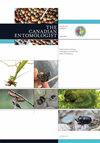Citizen science reveals the establishment of Chamaesphecia empiformis (Esper) (Lepidoptera: Sesiidae), a long-lost biological control agent for Euphorbia cyparissias (Euphorbiaceae), in Ontario, Canada
IF 1.1
4区 农林科学
Q3 ENTOMOLOGY
引用次数: 0
Abstract
Abstract The European root-boring moth, Chamaesphecia empiformis (Lepidoptera: Sesiidae), was released in Ontario, Canada, in 1971 and 1989 as a biological control agent for the perennial invasive weed cypress spurge, Euphorbia cyparissias Linnaeus (Euphorbiaceae). Until recently, the moth was believed to have failed to establish. Beginning in 2015, images posted on citizen science platforms, including BugGuide, iNaturalist, and Facebook groups, indicated that C. empiformis was in fact established. We have confirmed its presence in eastern Ontario by morphological and molecular identification of field-collected adults and eggs. This may be the longest-known lapse between the release of a weed biological control agent and confirmation of its establishment. Citizen science may provide valuable records documenting the establishment and dispersal of biological control agents.公民科学揭示了在加拿大安大略省发现的一种遗失已久的大戟科(Euphorbia cyparissias)生物防治剂Chamaesphecia empiformis (Esper)(鳞翅目:大戟科)
摘要:1971年和1989年,在加拿大安大略省释放了欧洲蛀根蛾Chamaesphecia empiformis(鳞翅目:雪蛾科),作为对多年生入侵杂草大柏科大柏科大柏科大柏科大柏科大柏科大柏科大柏科大柏科大柏科植物的生物防治剂。直到最近,这种飞蛾才被认为没有立足。从2015年开始,在包括BugGuide、iNaturalist和Facebook群组在内的公民科学平台上发布的图像表明,事实上已经建立了C. empiformis。我们通过实地采集的成虫和卵的形态和分子鉴定证实了它在安大略省东部的存在。这可能是人们所知的从释放一种杂草生物防治剂到确认其建立之间最长的时间差。公民科学可以提供有价值的记录,记录生物防治剂的建立和扩散。
本文章由计算机程序翻译,如有差异,请以英文原文为准。
求助全文
约1分钟内获得全文
求助全文
来源期刊

Canadian Entomologist
生物-昆虫学
CiteScore
2.20
自引率
11.10%
发文量
24
审稿时长
6-12 weeks
期刊介绍:
French translation follows/le français suit Published since 1868, this peer-reviewed bimonthly publication is the official journal of the Entomological Society of Canada. Available via the internet and with hardcopy distribution to 55 countries, its research papers and notes are relevant to entomologists and other biologists around the world. In addition to being a venue for topical reviews and forum discussion, The Canadian Entomologist publishes current research in all facets of entomology, including systematics and morphology, molecular and developmental biology, ecology and behaviour, biodiversity and evolution, insect management, entomological techniques, and other relevant subject areas. Contributions are published in English or French. Authors will not pay page charges, and will experience fast, high quality reviews of their papers.Publiée depuis 1868, cette publication bimestrielle avec comité de lecture est la revue officielle de la Société d’entomologie du Canada. Disponible sur Internet et distribuée en format papier dans 55 pays, ses articles de recherche et ses notes sont pertinents pour les entomologistes et autres biologistes de par le monde. En plus d’être une plate-forme pour des revues thématiques et un forum de discussion, The Canadian Entomologist publie la recherche actuelle sur toutes les facettes de l’entomologie, incluant la systématique et la morphologie, la biologie moléculaire et développementale, l’écologie et le comportement, la biodiversité et l’évolution, la gestion des insectes, les techniques entomologiques et d’autres domaines pertinents. Les contributions sont publiées en français ou en anglais. Les auteurs ne paient aucun frais de publication, et recevront une révision rapide et de grande qualité de leurs articles.
 求助内容:
求助内容: 应助结果提醒方式:
应助结果提醒方式:


